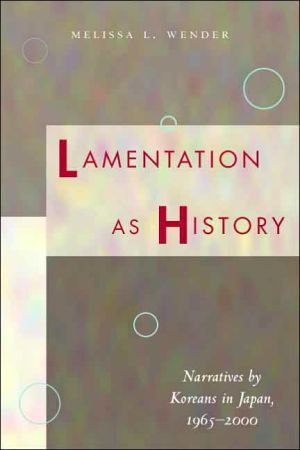

 |

|

The average rating for Lamentation as History: Narratives by Koreans in Japan, 1965-2000 based on 2 reviews is 4.5 stars.
Review # 1 was written on 2013-06-30 00:00:00 Steven Salazar Steven SalazarI read this book a couple years ago and absolutely loved it. I had borrowed it from the library and decided to get a copy when I got my bonus last year. I started to re-read it as I'm writing a 17th century ghost story set in China and thought it would help to refresh my memory. I enjoyed reading this just as much the second time. The book has three sections looking at ghosts in literature, poetry and plays. Zeitlin looks at the gendered representation of the ghosts and how their portrayal varies between the different mediums. This isn't a book looking at what was believed about ghosts but rather how they were shown and what they represented. 46 talks about ghosts dying and becoming the ghosts of ghosts 60-61 has ghost poems from the tang 78-81 Mei's record of talented ghosts, women's poetry anthologies, 122-123 massacure at the end of the ming and ghost story 150-151;156-157 ghost walk I'm so glad I have a copy of this and enjoyed re-reading it. I'm sure I will re-read it several more times and it will be an excellent reference work as well. Review from first reading Sept 08 Wow! This may be my new favorite non-fiction book. It's definitely the best I've read all year. Zeitlin managed to touch on all my favorite sources for Chinese ghost stories, including the obvious Pu Songling and Mu Dan Ting (the Peony Pavillion). She even started by discussing Tsai Hurak's Chinese Ghost Story. She looked at how ghosts became the ideal of womanly beauty at the end of the Ming, as the embodiment of qing. She then went on to look at poetry that was attributed to ghosts. This included poets writing as if they were already dead, including Li He, who I'd totally forgotten but really like as he's particularly beautiful and morbid. (70-71). Zeitlin quotes a Ming critic, Wang siren, talking about Li He saying, "When someone's life is careening to a close, lovely scenery seems pointless. That's why he set his disturbed and mournful thoughts to such an obscure tune. He liked to use words such as Ghost, Weeping, Death and Blood. When someone's poetry is dark, chiling and perverse, as a rule they will die young." She went on to follow the tradition of ghost poems from one's attributed to real people, to those attributed to ghosts and those written by people in seances. Eventually the trend changed from dead scholars to ghostly women composing poetry. Chapter 3 looked at ghosts as a path to historical time. Young men would wander to a particular historical site and be so overwhelmed by feelings of the past that they would be visited by ghosts. Often these ghosts were at the fall of a dynasty, or killed unfairly. Most were palace women who because of their seclusion could tell little about the time that they lived in. Poems set in this vein are called huaigu in chinese, which is translated as "poetic reflections stimulated by visits to historic sites". Chapters 4 and 5 look at the ghost heroine in Ming dramas. Following on the success of the Peony Pavillion there were many women ghosts in plays. Some who came back to life and those who returned only briefly. Some of the examples given were highly amusing. Zeitlin ended up looking at the Palace of lasting Life, which I have a dual language shortened edition of as the Palace of eternal youth. The play follows Yang Guifei, the famous (chubby) courtesan who committed suicide to save Tang Minghuang during the An Lushan rebellion. When I first read the book I was not familiar with the history but now I really want to re-read it. In the full version Yang is a ghost for half the story, and revisits the scene of her death, and spends time living as an immortal in heaven, unfortunately I think the 2nd half is greatly condensed in my version. The book has everything I love, beautiful ghost women, tragic poetry, love of historical places and times, and chinese plays. The author has also written a book about Pu Songling which I must find, but unfortunately is not at SOAS, at least it seems reasonably cheap on amazon. This book costs £40. I liked it so much I wrote to the publishers to ask if a paperback was going to be released, but unfortunately as yet there are no plans for one. But I will definitely have to buy myself a copy at somepoint. |
Review # 2 was written on 2015-02-24 00:00:00 Kevin Gaudreault Kevin GaudreaultZeitlin brings much-needed new ideas to the table here - she frames the figure of the (female) phantom within the discourses of traditional Chinese medicine, music, theatre, visual culture, interrogating in the process the representational codes by which the 'gui' becomes embodied, so to speak. Two thumbs up. |
CAN'T FIND WHAT YOU'RE LOOKING FOR? CLICK HERE!!!